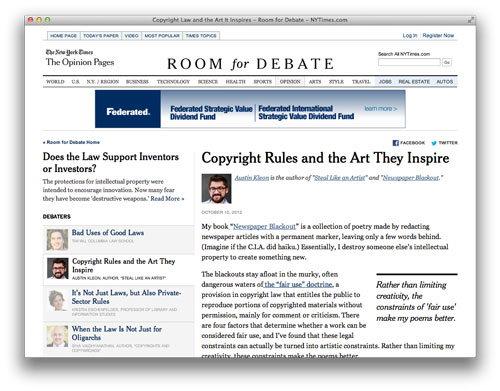I wrote a little piece this morning for the New York Times‘ “Room For Debate” section on how turning the constraints of fair use into artistic constraints actually leads me to make better blackout poems. Read it here, or below.
My book “Newspaper Blackout” is a collection of poetry made by redacting newspaper articles with a permanent marker, leaving only a few words behind. (Imagine if the C.I.A. did haiku.) Essentially, I destroy someone else’s intellectual property to create something new.
The blackouts stay afloat in the murky, often dangerous waters of the “fair use” doctrine, a provision in copyright law that entitles the public to reproduce portions of copyrighted materials without permission, mainly for comment or criticism. There are four factors that determine whether a work can be considered fair use, and I’ve found that these legal constraints can actually be turned into artistic constraints. Rather than limiting my creativity, these constraints make the poems better.1. “The Transformative Factor”: I try to disfigure the original article in such a way that the resulting poem has no resemblance to the original subject matter, or if it does, it parodies or reverses that subject matter.
2. “The Nature of the Copyrighted Work”: The more “nonfiction” and mundane the section the better the transformation. (Although, the sports section tends to be the most filled with everyday speech and metaphors, therefore the easiest.)
3. “The Amount and Substantiality of the Portion Taken”: The fewer words I use from the original, and the more I chop them up, the more the poem sounds like me.
4. “The Effect of the Use Upon the Potential Market”: The blackouts are not a degradation of the newspaper, but a celebration. Several savvy newspapers have recognized this, running their own blackout poetry contests in which they encourage readers to buy a Sunday edition and try their own.
Of course, one man’s fair use is another’s infringement, and unfortunately, the burden of proof in a fair use case is on the defendant, who, often lacking the money to fight in court, has no choice but to cease and desist. Many artists have suffered this fate, and so I continue making the blackouts with fingers crossed for a litigation-free future.
